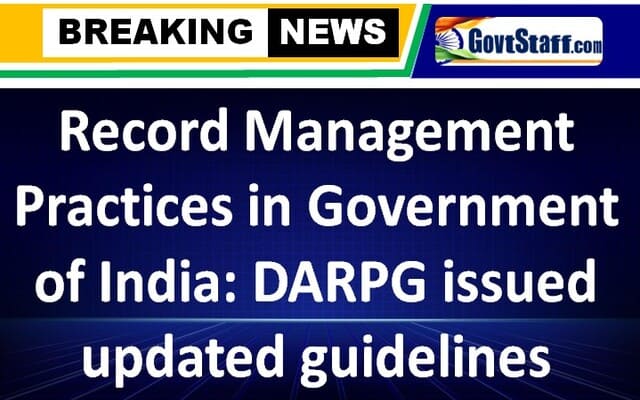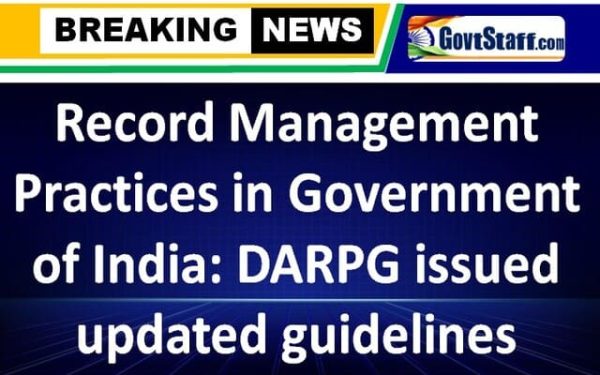Record Management Practices in Government of India: DARPG issued updated guidelines vide OM dated 01.08.2025
No. Q-15011/1/2025-O&M -DARPG
Government of India
Ministry of Personnel, Public Grievances & Pensions
Department of Administrative Reforms & Public Grievances
Jawahar Vyapar Bhavan, New Delhi
Dated: 01st August, 2025
OFFICE MEMORANDUM
Sub: Record Management Practices in Government of India.
The Department of Administrative Reforms & Public Grievances (DARPG) deals with the subject of Record Retention Schedule (RRS) of records created in the Government of India.
The Broad guidelines for Record management for physical as well as e-Files are explained in Chapter 10 of the Central Secretariat Manual of Office Procedure (CSMoP 2022), read with provisions of the Public Records Act, 1993 and the Public Record Rules, 1997, relevant portions of which are as follows:
Section 8 and Section 9 of the Public Records Act, 1993
8. Destruction or disposal of public records.—
(1) Save as otherwise provided in any law for the time being in force, no public record shall be destroyed or otherwise disposed of except in such manner and subject to such conditions as may be prescribed.
(2) No record created before the year 1892 shall be destroyed except where in the opinion of the Director General or, as the case may be, the head of the Archives, it is so defaced or is in such condition that it cannot be put to any archival use.
9. Penalty for contraventions.—
Whoever contravenes any of the provisions of section 4 or section 8 shall be punishable with imprisonment for a term which may extend to five years or with fine which may extend to ten thousand rupees or with both.
Section 9 of Public Record Rules, 1997
9. Destruction of Public Records.—
(1) No public record shall be destroyed without being recorded and revised. In the month of January every year, each records creating agency shall record after consulting the records retention Schedule all those files on which action has been completed. This work shall be accomplished in consultation with the Records Officer.
(2) No public record which is more than twenty-five years old shall be destroyed by any records creating agency unless it is appraised.
(3) A list of all such public records which are proposed to be destroyed shall be prepared by the record creating agency in Form 6 and retained permanently for future reference.
(4) The Record Officer shall furnish a half yearly report in Form 7 on recording, indexing, 74/20/reviewing and weeding of records to the Director General or Head of the Archives, as the case may be.
(5) Records shall be destroyed either by burning or shredding in the presence of Record Officer.
3. The Chapter 10 of CSMOP, 2022 has laid down the activities involved in Record Management, Categorization of Records, Record Retention Schedules, Review and Weeding of Records, Maintenance, Transfer of Records, Personal Office Records etc.
Relevant Provisions of Para 10.7 and Para 10.9 of the CSMOP, 2022 are as follows:
10.7. Record Retention Schedule:
(i) To ensure that files are neither prematurely destroyed, nor kept for periods longer than necessary, every department will:
a. in respect of records connected with accounts, observe the instructions contained in Appendix 9 to the General Financial Rules, 2017;
b. in respect of records, relating to establishment, housekeeping matters, etc. common to all departments, follow the schedule of periods of retention for records common to all departments’ issued by the Department of Administrative Reforms and Public Grievances (SI.No.15 in Table 4.2)
c. in respect of records prescribed in this Manual, observe the retention periods specified in Appendix 10.10; and
d. in respect of records connected with its substantive functions departmental instructions issued for departmental retention schedule prescribing the periods should be preserved in consultation with the National Archives of India.
ii) The above schedules should be reviewed at least once in 5 years.
10.9. Review and weeding of records:
(i) A category ‘C’ file will be reviewed on the expiry of the specified retention period and weeded out unless there are sufficient grounds warranting its further retention. Justification for retaining a file after review will be recorded on the file with the approval of Branch Officer/Divisional Head concerned. Retention after a review will be for a period not exceeding 10 years, including the period already retained.
(ii) Category ‘A’ & ‘B’ files will be reviewed on attaining the 25th year of their life in consultation with the National Archives of India. In these reviews the need for revising the original categorisation of category ‘B’ files may also be considered.
(iii) The year of review of category ‘C’ files will be reckoned with reference to the year of their closing and that for category ‘A’ and category ‘B’ files with reference to the year of their opening.
4. In light of the above provisions, following extensive consultation with various Ministries/Departments the Guidelines of Record Management are further clarified as follows:
a) e-files of ‘C’ category like Parliament Questions, Dak Register, Messenger Book, File Movement Register, Register for watching the progress of recording, Register for keeping a watch on communications received from MPs/VIPs, Register of Parliamentary Assurances are to be retained for a period of 3 years and thereafter closed with due approvals of competent authority.
b) e-files of ‘C’ category like the Record Review Register, List of files received for review, Monthly Progress Report on recording of files, Check-lists for periodical reports, Inspection reports to be closed after retention a period of one year as per the Records Retention Schedule with due approval of competent authority.
c) e-files of ‘A’ category to be retained as permanent record. Such records include Standing Guard Files, File Registers, Precedent Book, List of files transferred to National Archives and Record Retention Slip.
5. It should be noted that Sections 8(1) and 9 of the Public Records Act, 1993 and the procedures laid down in Rule 9 of the Public Records Rule, 1997 would apply equally to e-Files.
6. This issues with the approval of the Competent Authority.
Sd/-
(Hari Krishan Bhatt)
Deputy Secretary to the Government of India



COMMENTS